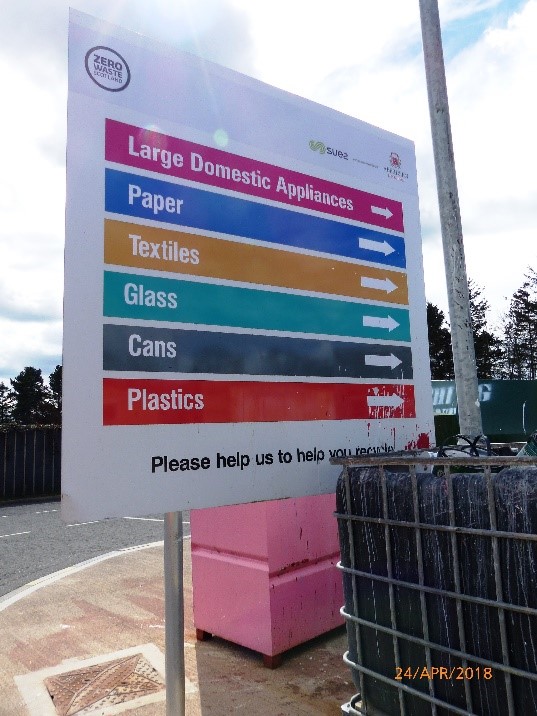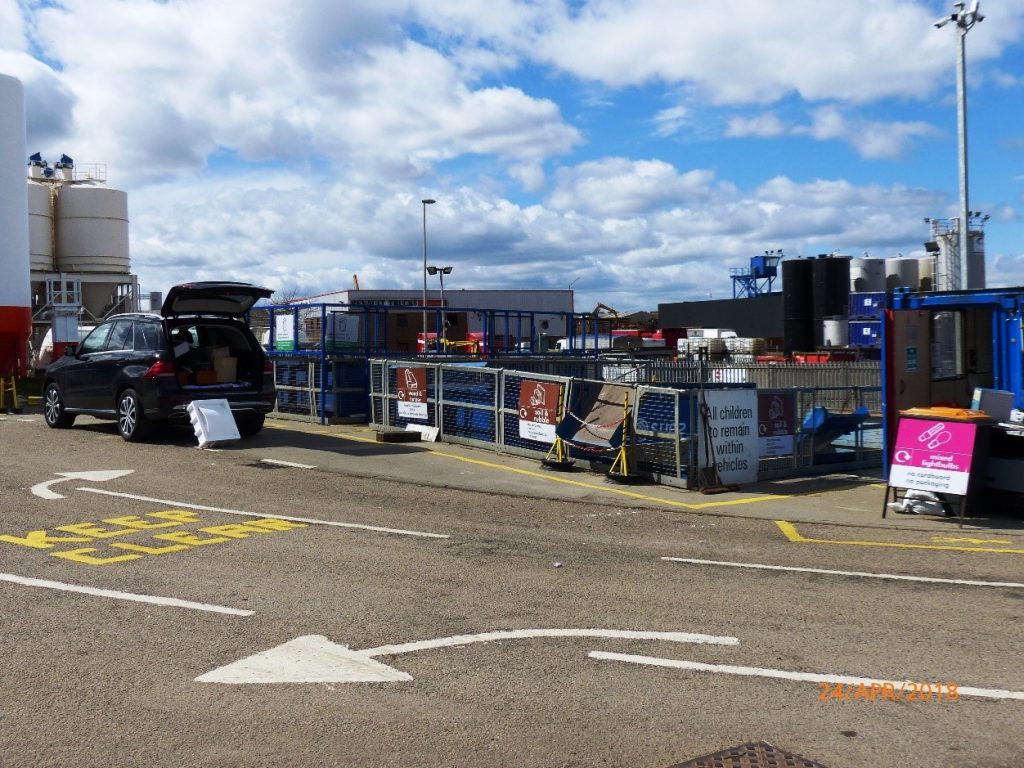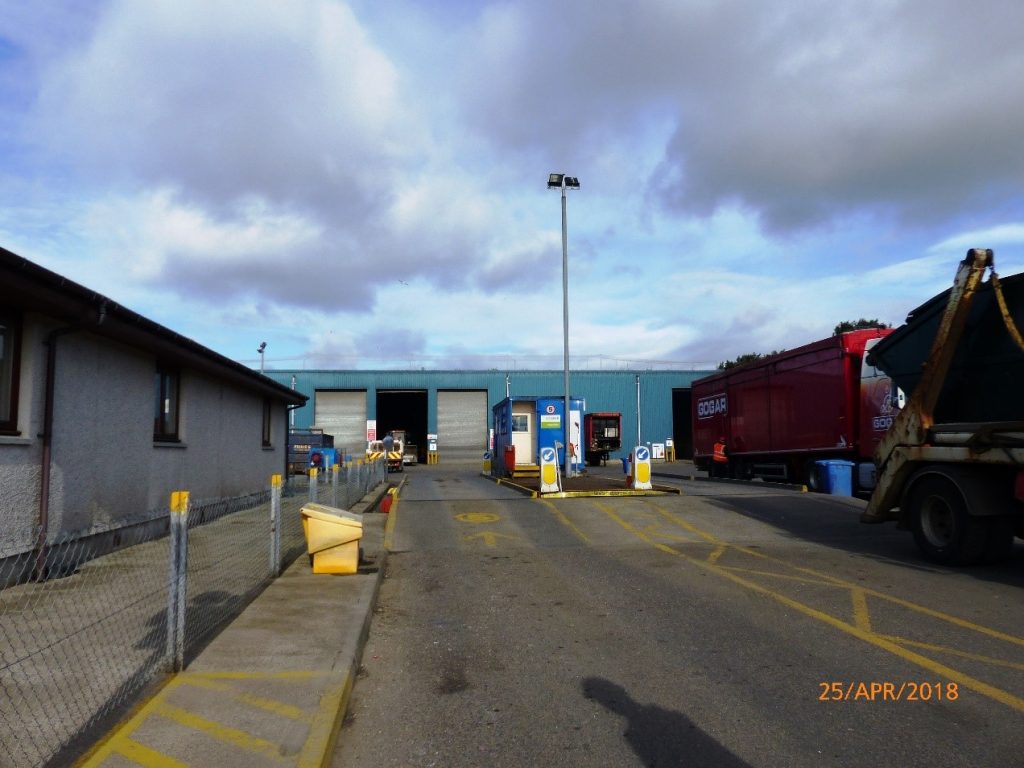SUEZ site-seeing | Part 15 | Aberdeen Household Waste Recycling Centre’s and Transfer Stations
24th August 2018
Following a successful and busy morning at the Aberdeen materials recycling facility (MRF) and refuse derived fuel (RDF) site, checking out the processing engineering my next stop was at the local household waste recycling centres that SUEZ operate on behalf of Aberdeen City Council.
Stop two | Aberdeen Household Waste Recycling Centres (HWRCs)
SUEZ recycling and recovery UK operate five HWRC’s in the city, managing 23,000 tonnes per annum of waste (and some recyclables etc.) that arrive on site from local residents. The first site I visited was East Tullos, which deals with 5,000 tonnes per annum of waste material. It is an old site, with a small footprint which has been operational since 2002. It has always been considered too small, but is very effective. The former Transfer Station (which is also located here) was closed once the new MRF & RDF plant opened, and the site is now being used for bin storage and repair etc.

All materials accepted at this HWRC
The HWRC has been re-designed recently (using open cages to enable residents to see what is in each bay etc.) to make the best use of the small footprint. The public are adapting with every visit, allowing the site to target new materials and encourage re-use and repair on site too. The sites diversion performance (reducing the amount of waste going to landfill) has also improved, and the local team are busy reclaiming old containers to assist with the drive for more re-use and repair.
As older sites go, this was pretty impressive, and the local team were excellent in all aspects of site maintenance and engagement. Whilst on site, I was fully inducted, shown how the new cage system works, taken through their plans for redeveloping some of the reuse and repair containers, and watched the team meet customers at the gate and direct them to the most appropriate part of the site to reduce risk and traffic jams etc. They even helped a few customers out with heavy items, and certainly left a good impression on the local residents (and me!).
Then it was time to move on again, I was off to look at a site that was as far removed from East Tullos as possible, the newly created Grove site which manages 8,000 tonnes per annum and was opened in 2014 (it is the busiest of the Aberdeen sites). This site is very much the benchmark for all other HWRCs in the region, designed on a large footprint, with a full range of target materials accepted, plus a re-use shop and a one-way traffic management system feeding a split-level containerised site. This design gave the site an excellent layout and lots of space, making it far more customer friendly.
The meet and greet team were very active, helping direct customers to the relevant bays, helping the site deliver 80% of materials to recycling, reuse and repair outlets. Very impressive, and the local team demonstrated exactly the same attention to detail, willingness to help, and passion for what they do as the team at the older and smaller site, a testament to the regional management team I suspect!
After a brief stop, it was back in the car for the long journey north to Inverness, where I would spend the night (a beautiful city on the river and by the Loch) for the next set of sites before I headed south towards Edinburgh and my flight home.

New cage system at East Tullos HWRC
Stop three | Inverness Transfer Station

Welcome to Inverness Transfer Station
This transfer station manages 50,000 tonnes per annum on behalf of Highland Council. The residual waste is bulked up and sent on to our Byker refuse derived fuel (RDF) facility in Newcastle, whilst the food waste is bulked up and sent on for reprocessing, the mixed dry recycling is bulked up and sent to our Aberdeen MRF. Currently the site is sending 18,000 tonnes per annum of dry recycling to Aberdeen for segregation.
The site is well managed, with good signage, clear traffic management and is very clean, but it is a long way from anywhere, pretty much three hours by road to any of Scotland’s major processing sites, including our own in Aberdeen and Binn Farm (near Edinburgh) sites, so effective handling, compaction and getting the payloads right on every vehicle movement is key to making the operation work financially.
The dry recycling was very high quality on inspection with on average 8% contamination (non-target items), and Highland Council should receive the plaudits for this on the back of their campaigning and constant messaging etc. The contamination levels are monitored closely when the mixed material is delivered to Binn Farm facility in Edinburgh.
The team were highly motivated and pulling out extra recyclables from the loads tipped at the site, and were also running WEEE segregation and wood recovery on site (this goes on to our Binn Farm site too to be processed). Their enthusiasm and energy was a real positive for me, and given the site’s isolated location they were still very in tune with the corporate quality assurance and health and safety systems, including the lean processing approaches being adopted across all our sites to improve productivity.
The visit also enabled me to sit down with our client, Highland Council, and talk about the state of the commodity markets, listen to his ideas on greater harmonisation in services across the Highland region, and to hear first-hand the positive feedback about the SUEZ service and employees.
But, after a quick cup of tea it was back in the car for the three hour trip to Binn Farm.
Tweet- Aberdeen
- Aberdeen City Council
- Highland Council
- Household Waste Recycling Centre
- rail transfer station
- site tour
- study tour
